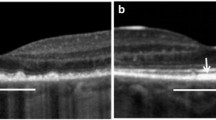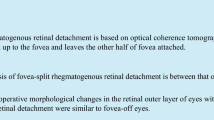Abstract
Purpose
Patients with Stargardt’s disease usually have a poor visual prognosis. However, in our clinical practice we have observed some patients with dark-red foveal pigmentation (sparing) who had good best corrected visual acuity (BCVA) despite the presence of a late-stage disease. The purpose of this study was to investigate the BCVA outcomes in Japanese patients with Stargardt’s disease with foveal sparing.
Methods
Eighteen consecutive patients (36 eyes) with Stargardt’s disease underwent ophthalmoscopy, fluorescein angiography, fundus autofluorescence imaging, and near-infrared fundus autofluorescence (NIA) imaging. The patients were divided into two groups based on the presence or absence of foveal sparing. The presence of foveal sparing was determined based on ophthalmoscopy and NIA imaging results. The association between foveal sparing and BCVA was assessed statistically by Students’ t test.
Results
Of the 36 eyes, ten (27.8 %) had dark-red foveal sparing. The mean BCVA of the group with sparing was 0.16 ± 0.31, expressed in logarithm of the minimum angle of resolution (logMAR) units, and that of the group without sparing was 1.03 ± 0.39 logMAR units, which is a significant difference (p = 0.0000002507).
Conclusion
A subgroup of Japanese patients with late-stage Stargardt’s disease and dark-red foveal sparing maintained a relatively good BCVA. The pigmentation was clearly observed using NIA and proved useful for assessing the BCVA prognosis.


Similar content being viewed by others
References
Stargardt K. Über familiäre, progressive degeneration in der maculagegend des auges. Albrecht von Graefe Archiv für Ophthalmologie. 1909;71:534–50.
Jimenez-Sierra JM, Ogden TE, Van Boemel GB. Inherited retinal diseases: a diagnostic guide. St Louis: Mosby; 1989.
Hadden OB, Gass DM. Fundus flavimaculatus and Stargardt’s disease. Am J Ophthalmol. 1976;82:527–39.
Noble KG, Carr RE. Stargardt’s disease and fundus flavimaculatus. Arch Ophthalmol. 1979;97:1281–5.
Rotenstreich Y, Fishman GA, Anderson RJ. Visual acuity loss and clinical observations in a large series of patients with Stargardt disease. Ophthalmology. 2003;110:1151–8.
Keilhauer CN, Delori FC. Near-infrared autofluorescence imaging of the fundus: visualization of ocular melanin. Invest Ophthalmol Vis Sci. 2006;47:3556–64.
Gass JD. Stereoscopic atlas of macular diseases: diagnosis and treatment. 4th ed. St Louis: Mosby; 1997.
Deutman AF, Hoyng CB, Lith-Verhoeven JC. Macular Dystrophies. In: Ryan S, editor. Retina. 4th ed. Philadelphia: Mosby Elsevier; 2006. p. 1171–5.
Allikmets R, Shroyer NF, Singh N, Seddon JM, Lewis RA, Bernstein PS, et al. Mutation of the Stargardt disease gene (ABCR) in age-related macular degeneration. Science. 1997;277:1805–7.
Klevering BJ, Deutman AF, Maugeri A, Cremers FP, Hoyng CB. The spectrum of retinal phenotypes caused by mutations in the ABCA4 gene. Graefes Arch Clin Exp Ophthalmol. 2005;243:90–100.
Shroyer NF, Lewis RA, Allikmets R, Singh N, Dean M, Leppert M, et al. The rod photoreceptor ATP-binding cassette transporter gene, ABCR, and retinal disease: from monogenic to multifactorial. Vis Res. 1999;39:2537–44.
Allikmets R. A photoreceptor cell-specific ATP-binding transporter gene (ABCR) is mutated in recessive Stargardt macular dystrophy. Nat Genet. 1997;17:122.
Hubbard AF, Askew EW, Singh N, Leppert M, Bernstein PS. Association of adipose and red blood cell lipids with severity of dominant Stargardt macular dystrophy (STGD3) secondary to an ELOVL4 mutation. Arch Ophthal. 2006;124:257–63.
Nishiguchi KM, Sandberg MA, Gorji N, Berson EL, Dryja TP. Cone cGMP-gated channel mutations and clinical findings in patients with achromatopsia, macular degeneration, and other hereditary cone diseases. Hum Mutat. 2005;25:248–58.
Yang Z, Chen Y, Lillo C, Chien J, Yu Z, Michaelides M, et al. Mutant prominin 1 found in patients with macular degeneration disrupts photoreceptor disk morphogenesis in mice. J Clin Invest. 2008;118:2908–16.
Molday RS, Zhong M, Quazi F. The role of the photoreceptor ABC transporter ABCA4 in lipid transport and Stargardt macular degeneration. Biochim Biophys Acta. 2009;1791:573–83.
Liu J, Itagaki Y, Ben-Shabat S, Nakanishi K, Sparrow JR. The biosynthesis of A2E, a fluorophore of aging retina, involves the formation of the precursor, A2-PE, in the photoreceptor outer segment membrane. J Biol Chem. 2000;275:29354–60.
Sparrow JR, Parish CA, Hashimoto M, Nakanishi K. A2E, a lipofuscin fluorophore, in human retinal pigmented epithelial cells in culture. Invest Ophthalmol Vis Sci. 1999;40:2988–95.
Sparrow JR, Vollmer-Snarr HR, Zhou J, Jang YP, Jockusch S, Itagaki Y, et al. A2E-epoxides damage DNA in retinal pigment epithelial cells. Vitamin E and other antioxidants inhibit A2E-epoxide formation. J Biol Chem. 2003;278:18207–13.
Delori FC, Dorey CK, Staurenghi G, Arend O, Goger DG, Weiter JJ. In vivo fluorescence of the ocular fundus exhibits retinal pigment epithelium lipofuscin characteristics. Invest Ophthalmol Vis Sci. 1995;36:718–29.
Smith-Thomas L, Richardson P, Thody AJ, Graham A, Palmer I, Flemming L, et al. Human ocular melanocytes and retinal pigment epithelial cells differ in their melanogenic properties in vivo and in vitro. Curr Eye Res. 1996;15:1079–91.
Peters S, Kayatz P, Heimann K, Schraermeyer U. Subretinal injection of rod outer segments leads to an increase in the number of early-stage melanosomes in retinal pigment epithelial cells. Ophthalmic Res. 2000;32:52–6.
Weinberger AW, Lappas A, Kirschkamp T, Mazinani BA, Huth JK, Mohammadi B, et al. Fundus near infrared fluorescence correlates with fundus near infrared reflectance. Invest Ophthalmol Vis Sci. 2006;47:3098–108.
Kellner S, Kellner U, Weber BH, Fiebig B, Weinitz S, Ruether K. Lipofuscin- and melanin-related fundus autofluorescence in patients with ABCA4-associated retinal dystrophies. Am J Ophthalmol. 2009;147:895–902.
Acknowledgments
This study was supported by a Grant-in-Aid from the Ministry of Education, Culture, Sports, Science and Technology (to M.T.) and by a Grant-in-Aid from the Ministry of Health, Labour and Welfare (to M. T.).
Author information
Authors and Affiliations
Corresponding author
Electronic supplementary material
Below is the link to the electronic supplementary material.
About this article
Cite this article
Nakao, T., Tsujikawa, M., Sawa, M. et al. Foveal sparing in patients with Japanese Stargardt’s disease and good visual acuity. Jpn J Ophthalmol 56, 584–588 (2012). https://doi.org/10.1007/s10384-012-0172-1
Received:
Accepted:
Published:
Issue Date:
DOI: https://doi.org/10.1007/s10384-012-0172-1




